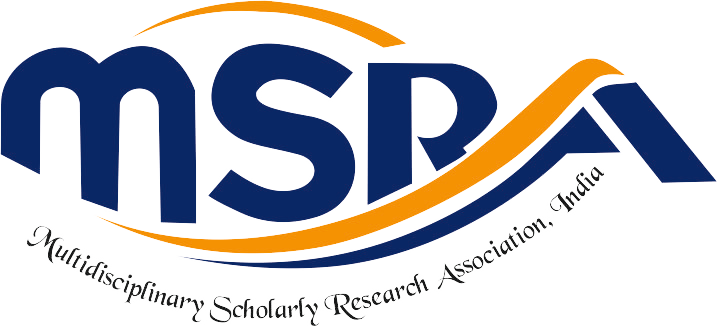Original Research Article
|
Oct. 31, 2024
289 Downloads
EXPLORING THE IMPACT OF SOCIAL MEDIA ON YOUTH: A COMPREHENSIVE ANALYSIS
Dr. Oneza Farid
DOI : 10.5281/AMIERJ.14547141
Abstract
Certificate
The study looks on how social media affects youth. Our lives are greatly influenced by technology and innovation, therefore it's critical that we have the skills needed to effectively handle them. Educating youngsters how to use social media can help them excel in their careers and advance personally. On the other hand, overuse of social media has been connected to a number of behavioural health issues, such as disordered eating and problems with self-image. Mixed results have been observed in the research on this topic; for example, some studies have shown that social media use has a significant detrimental effect on mental health. It is worrisome to learn that in recent years, there has been a significant increase in the rates of various mental health conditions among adolescents, including depression and suicide. The rise of social media has coincided with a deterioration in mental health among adolescents and young adults in India, leading to concerns that these platforms may negatively affect mental well-being. This paper explores the relationship between social media use and mental health through correlational and descriptive analyses. Utilizing a generalized difference-in-differences empirical approach, we examine youth mental health data in relation to usage of Social media. Our findings indicate that the introduction of Facebook correlates with an increase in symptoms of poor mental health, particularly depression. Additionally, we observe that students who are most vulnerable to mental health issues show a rise in the use of mental healthcare services following Facebook's introduction. The study also reveals that students are more likely to report experiencing impactive effects after Facebook’s launch. The data for this research was collected via Google Forms and supplemented with case studies, providing insights into how today's youth's extensive social media use and uncritical consumption of online content may impact their mental health.
Original Research Article
|
Oct. 31, 2024
225 Downloads
PROMOTING SANITATION AND HYGIENE IN SCHOOLS
Ranjita Ramesh Kalebere & Dr. Sopan Govind Khade
DOI : 10.5281/AMIERJ.14739010
Abstract
Certificate
Education and promotion of hygiene can play a vital role for developing public health and facing various obstacles in ensuring public health for all citizens. School can take an active role for promoting school sanitation and hygiene. The components of hygiene and sanitation encompass various practices, infrastructure, and behaviors aimed at promoting cleanliness, health, and wellbeing like personal hygiene, environmental hygiene, and food hygiene. School can advocate various innovative techniques for betterment of school sanitation and hygiene through behavior change activities. Promotion of Sanitation and hygiene in schools can provide happy and healthy learning environment for all the students. It will help to reduce health related issues and will also help to improve attendance rate and academic achievement of the students.
Original Research Article
|
Oct. 31, 2024
335 Downloads
A STUDY OF STATE WISE INFLOW OF FOREIGN DIRECT INVESTMENT IN INDIA
Dr. Balkrishna Ambaji Dalvi
DOI : 10.5281/AMIERJ.14739034
Abstract
Certificate
Education and promotion of hygiene can play a vital role for developing public health and facing various obstacles in ensuring public health for all citizens. School can take an active role for promoting school sanitation and hygiene. The components of hygiene and sanitation encompass various practices, infrastructure, and behaviors aimed at promoting cleanliness, health, and wellbeing like personal hygiene, environmental hygiene, and food hygiene. School can advocate various innovative techniques for betterment of school sanitation and hygiene through behavior change activities. Promotion of Sanitation and hygiene in schools can provide happy and healthy learning environment for all the students. It will help to reduce health related issues and will also help to improve attendance rate and academic achievement of the students.
Original Research Article
|
Oct. 31, 2024
213 Downloads
CHALLENGES FACED BY DISABLED TEACHERS IN INDIA: AN ACADEMIC PERSPECTIVE
Dr. Kalpana Kharade
DOI : 10.5281/AMIERJ.14739045
Abstract
Certificate
Foreign direct investment inflow plays very important role in the economic development of the host country. Developing and under developed countries are trying hard to attract more and more FDI. Within the countries, the states of those counties are also fighting amongst themselves for attracting maximum FDI. India has 28 states and 8 Union territories which are trying to lure foreign companies under FDI so that large corporate start their businesses in their states.
The present study tried to focus top ten states of India who attracts almost 98 percent of total FDI. Researcher have not considered the remaining 18 states for the study. The present study is based on secondary data which is obtained from annual reports of Department for Promotion of Industry and Internal Trade (DPIIT). The current status of FDI in India has been discerned in the present study. FDI inflow of top ten states has been studied and tried to find out who have secured highest FDI in the last three years.
Original Research Article
|
Oct. 31, 2024
218 Downloads
A STUDY ON BLENDED LEARNING IN INDIA – SCOPE AND CHALLENGES
Ms. Sonia Chauhan & Ms. Monika Chauhan
DOI : 10.5281/AMIERJ.14739155
Abstract
Certificate
India, known for its cultural diversity and increasing emphasis on inclusive education, acknowledges the necessity of integrating individuals with disabilities into all areas of society. However, disabled teachers—essential contributors to the education system—encounter numerous obstacles that limit their professional growth and ability to make broader contributions. This paper examines these barriers, grouped into structural, societal, institutional, and personal categories, identifies policy implementation gaps, and offers practical recommendations.
Original Research Article
|
Oct. 31, 2024
256 Downloads
BIBLIOMETRIC ANALYSIS OF JOURNAL OF THE INTERNATIONAL ASSOCIATION OF BUDDHIST UNIVERSITIES
Anupama Sonaji Sonwane & Dr. Shashank S. Sonwane
DOI : 10.5281/AMIERJ.14739196
Abstract
Certificate
The present study is based on the Bibliometric analysis of 203 research article on Journal of the International Association of Buddhist Universities during the period of 2008-2019. This Study will review on year-wise distribution, Authorship pattern of contributions, Author wise distribution, Institution wise distribution, country-wise distribution, etc. The findings must reveal various aspects of the characteristics and patterns of contributions of the study.
Original Research Article
|
Oct. 31, 2024
224 Downloads
EXPLORING AUTHORSHIP DISTRIBUTION AND COLLABORATIVE TRENDS IN DATA VISUALIZATION PUBLICATIONS 2001-2020 INDEXED IN LISA
Ms. Pradnya K. Kivande & Dr. Shashank S. Sonwane
DOI : 10.5281/AMIERJ.14739251
Abstract
Certificate
The study examines the authorship patterns and collaboration coefficients of publications on data visualization indexed in the Library and Information Science Abstracts (LISA) database between 2001 to2020. A total of 7,144 articles published during this period were analyzed using scientometric methods. The analysis explored the trends in authorship, identifying the proportion of single-authored and multi-authored papers, and assessed the degree of collaboration among researchers in the field. The study also calculated the collaboration coefficient to quantify the extent of collaborative efforts in data visualization research. The findings provide valuable insights into the evolving nature of research collaboration, authorship trends, and the dynamics of knowledge production in the domain of data visualization within library and information science. These insights contribute to a better understanding of how researchers in this field engage and collaborate over two decades, offering implications for fostering interdisciplinary and collaborative approaches in future research.
Original Research Article
|
Oct. 31, 2024
277 Downloads
EMBRACING HERITAGE: "REVIVING INDIGENOUS SPORTS AND EXERCISE FOR CULTURAL VITALITY AND WELLNESS”
Dr. Vishwambhar Jadhav & Deksha Shetty
DOI : 10.5281/AMIERJ.14739339
Abstract
Certificate
This paper explores the significance of promoting indigenous sports and exercise as a means to revive cultural heritage and enhance holistic well-being within indigenous communities. Traditional sports and exercises have deep rooted connections to the culture, history, and spirituality of indigenous peoples. Through a comprehensive review of the literature and case studies, this highlights the physical, mental, and social benefits of engaging in indigenous sports and exercises. The research underscores the role of indigenous sports in fostering community cohesion, preserving cultural traditions, and empowering individuals to reconnect with their roots. Moreover, the positive impact of physical activity on mental health and emotional resilience is discussed, shedding light on how traditional sports can contribute to holistic well-being.
The current paper also insisted that schools, colleges, and universities should start such sports and physical activities and make them compulsory for the curriculum. For instance.in the recent 75th Azadi Amrut Mahotsav we celebrated 75 crore Surya Namaskar, such activities shall also embrace our heritage of indigenous sports and exercise.
Original Research Article
|
Oct. 31, 2024
307 Downloads
ROLE OF SELF EFFICACY IN ACADEMIC STRESS IN SENIOR SECONDARY SCHOOL STUDENTS : A THEORETICAL PERSPECTIVE
(Prof.) Dr. Aruna Anchal & Mrs. Karishma
DOI : 10.5281/AMIERJ.14739364
Abstract
Certificate
Academic stress is a prevalent issue among senior secondary school students, often exacerbated by the pressure to perform well in exams and meet academic expectations. Self-efficacy, or the belief in one's ability to succeed in specific situations, plays a crucial role in how students manage and perceive academic stress through time management, confidence and making strategies. This paper explores the relationship between self-efficacy and academic stress, highlighting how high levels of self-efficacy can serve as a protective factor against stress.
Self-efficacy, a concept introduced by Albert Bandura in 1977, refers to an individual's belief in their capacity to execute behaviours necessary to produce specific performance attainments. It is a critical factor in determining how individuals approach tasks, challenges, and stressors, including those in academic settings. This paper explores the role of self-efficacy in academic stress, drawing on theoretical frameworks and empirical studies to understand the relationship between these constructs.
Academic stress is a common experience among students, driven by various factors such as high expectations, workload, and the pressure to perform well. It can lead to negative outcomes like anxiety, depression, and burnout. However, not all students experience stress in the same way or to the same degree. One of the factors that can influence the impact of academic stress is self-efficacy.The paper reviews existing literature, presents empirical evidence, and discusses practical implications for educators and policy-makers.
Original Research Article
|
Oct. 31, 2024
241 Downloads
A STUDY ON THE IMPACT OF DIGITAL TRANSFORMATION ON THE INDIAN ECONOMY
Mr. Dhananjay S. Channale
DOI : 10.5281/AMIERJ.14993148
Abstract
Certificate
The digital transformation of the Indian economy serves as a primary driver behind the nation's recent economic growth and development. Digitalization has proven to be a catalyst for growth, fostering innovation and inclusivity across various sectors, including finance, e-commerce, agriculture, healthcare, education, and entrepreneurship. This study explores the multifaceted impact of digital transformation on Indian economy, with a particular focus on key government initiatives such as Digital India, the Unified Payments Interface (UPI), Aadhaar, the Bharat Net Project, and Startup India. It assesses their achievements, influence, challenges, and contributions to economic growth, productivity, and employment. The research underscores the effects of government-led initiatives on the digitalization of the economy across multiple sectors. These efforts have positioned India as a global leader in digital innovation. However, challenges remain, such as the digital divide, cybersecurity risks, skill gaps, and regulatory obstacles, which continue to impede equitable digital progress. By analysing existing literature, secondary data, and global benchmarks, this study provides valuable insights for policymakers, businesses, and educators, offering guidance on how to maximize the potential of digital transformation in India.

